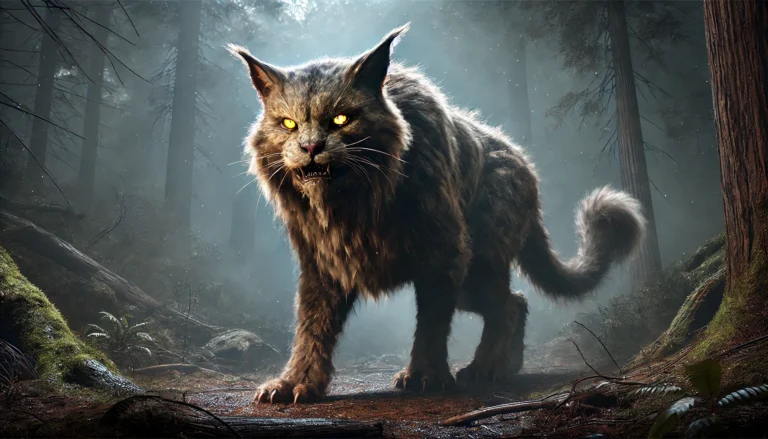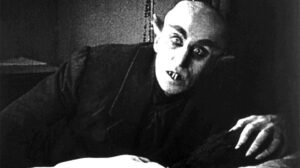Table of Contents
Origins and Family
The Wampus Cat, a creature steeped in the folklore of North America, particularly the Appalachian region, is a fascinating subject of myth and legend. Its origins are deeply rooted in Native American mythology, specifically among the Cherokee people. The name “Wampus” is believed to be derived from the Cherokee word “ewah,” which means “spirit” or “cat spirit.” This creature is often considered a cousin to other fearsome feline beings in folklore, such as the Manticore and the Nemean Lion of Greek mythology. However, it stands out due to its unique characteristics and the rich tapestry of stories surrounding it.
Appearance
The Wampus Cat is described as a formidable and terrifying creature. It is often depicted as a large, cat-like beast with glowing yellow eyes that pierce through the darkness. Its fur is said to be a blend of tawny and dark hues, providing excellent camouflage in the forested regions it inhabits. The creature’s muscular build, sharp claws, and teeth contribute to its fearsome reputation. Some tales suggest that it walks on its hind legs like a human, adding an eerie element to its appearance. Its face is said to be a grotesque blend of human and feline features, further enhancing its menacing aura.
Abilities

The Wampus Cat possesses a range of supernatural abilities that make it a formidable entity in folklore. One of its most notable abilities is its scream, a blood-curdling cry that can instill fear and paralysis in those who hear it. This scream is said to be so powerful that it can shatter glass and cause physical harm. Additionally, the Wampus Cat is believed to have the ability to shape-shift, blending seamlessly into its surroundings or taking on the appearance of other creatures to deceive its prey. It is also incredibly fast and agile, able to move silently through the dense forests it calls home.
Weakness
Despite its many strengths, the Wampus Cat is not without its vulnerabilities. According to legend, it is particularly susceptible to certain charms and spells. The Cherokee people believed that the creature could be warded off with specific rituals and incantations. Additionally, the Wampus Cat is said to have a weakness for certain types of wood, such as cedar, which can be used to create protective barriers against it. In some versions of the legend, the creature can be trapped or repelled using mirrors, which are believed to confuse and disorient it.
Behavior with Humans
The Wampus Cat’s interactions with humans are a central theme in many of the stories about it. In some tales, the creature is depicted as a vengeful spirit, seeking retribution against those who have wronged it or violated sacred taboos. For example, one popular legend tells of a Cherokee woman who, disguised in the skin of a mountain lion, spied on a sacred ceremony and was transformed into the Wampus Cat as punishment. In this form, she roams the forests, forever tormented by her actions.
Other stories portray the Wampus Cat as a guardian spirit, protecting the land and its inhabitants from harm. In these tales, the creature only becomes aggressive when provoked or when it senses a threat to its territory. Encounters with the Cat are often seen as omens, signaling either danger or the need for caution.
Symbols
The Wampus Cat is represented by several symbols that reflect its dual nature as both a fearsome predator and a protective spirit. The most common symbol is the cat itself, often depicted with exaggerated features such as glowing eyes and sharp claws. Other symbols include the moon, which is associated with the creature’s nocturnal habits and supernatural abilities. In some Native American art, the Wampus Cat is depicted with elements of fire and smoke, representing its connection to the spirit world and its ability to instill fear.
Related Myths and Stories

The legends of the Wampus Cat are numerous and varied, each adding to the rich tapestry of this mythical creature. One of the most famous stories is that of the Cherokee woman who was transformed into the Wampus Cat. This tale serves as a cautionary story about respecting sacred rituals and the consequences of breaking taboos.
Another popular story involves a group of settlers who encountered the Wampus Cat while exploring the Appalachian Mountains. According to the legend, the creature’s terrifying scream drove the settlers to flee, never to return to the area. This story highlights the Wampus Cat’s role as a guardian of the land, protecting it from intruders.
In yet another tale, the Wampus Cat is said to have helped a lost child find their way home. The creature, sensing the child’s distress, guided them through the forest, using its supernatural abilities to protect them from harm. This story portrays the Wampus Cat as a benevolent spirit, capable of compassion and kindness.
Other Creatures with Similar Abilities or Appearance
The Wampus Cat shares similarities with several other mythical creatures from various cultures. One such creature is the European Werewolf, which also possesses the ability to shape-shift and instill fear with its appearance and behavior. Like the Wampus Cat, werewolves are often depicted as both fearsome predators and protectors of their territory.
Another related creature is the Chupacabra of Latin American folklore. The Chupacabra, like the Wampus Cat, is a nocturnal predator known for its terrifying appearance and supernatural abilities. Both creatures are associated with unexplained livestock deaths and are feared by those who live near their supposed habitats.
In Asian mythology, the Bakeneko, a supernatural cat from Japanese folklore, shares several traits with the Wampus Cat. The Bakeneko is believed to have shape-shifting abilities, the power to curse humans, and a connection to the spirit world. These similarities highlight the universal fascination with feline creatures and their association with mystery and magic.
Conclusion
The Wampus Cat is a captivating and multifaceted creature of North American folklore. Its origins in Cherokee mythology, combined with its terrifying appearance and supernatural abilities, make it a subject of endless fascination. The creature’s interactions with humans, whether as a vengeful spirit or a protective guardian, add depth and complexity to its legend. Symbols such as the moon and the cat itself reflect the mythical creatures dual nature, while related myths and stories from various cultures underscore the universal appeal of feline mythical beings.
In exploring the Wampus Cat, we delve into the rich tapestry of folklore that defines human understanding of the natural and supernatural world. This creature, with its blend of fearsome and protective qualities, continues to captivate the imagination, serving as a reminder of the enduring power of myth and legend.
FAQ
What are the origins of the Wampus Cat?
The Wampus Cat originates from Native American mythology, particularly the legends of the Cherokee people. It is believed to be a spirit or cat spirit known as "ewah" in Cherokee.
What does the Wampus Cat look like?
The Wampus Cat is depicted as a formidable feline with glowing yellow eyes, a muscular build, and fur that blends tawny and dark hues. Some tales suggest it can walk on its hind legs and has a face combining human and feline features.
What abilities does the Wampus Cat have?
The Wampus Cat is known for its blood-curdling scream, shape-shifting abilities, and extraordinary speed and agility. It can also move silently and blend into its surroundings.
What are the weaknesses of the Wampus Cat?
The Wampus Cat is said to be vulnerable to certain charms, spells, and specific types of wood like cedar. Mirrors are also believed to confuse and disorient the creature.
How does the Wampus Cat interact with humans?
The Wampus Cat's interactions with humans vary. In some stories, it is a vengeful spirit punishing those who break sacred taboos, while in others, it acts as a protective guardian of the land.
What symbols represent the Wampus Cat?
Common symbols include the cat itself with exaggerated features, the moon, and elements of fire and smoke, all reflecting its nocturnal habits and supernatural powers.
Are there any related myths and stories?
Yes, numerous legends exist, including the tale of a Cherokee woman transformed into the Wampus Cat for spying on a sacred ceremony, and stories of the creature protecting the land or guiding lost children.
Are there similar creatures in other cultures?
Yes, similar creatures include the European Werewolf, the Latin American Chupacabra, and the Japanese Bakeneko, all of which share traits like shape-shifting and supernatural abilities.
Where is the Wampus Cat said to reside?
The Wampus Cat is primarily associated with the Appalachian Mountains and other forested regions of North America, where it is believed to roam and protect its territory.




